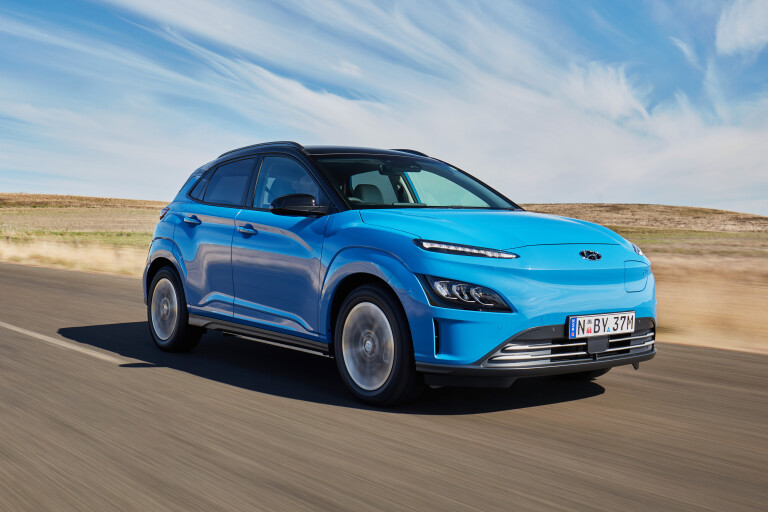
Things we like
- High spec feels premium enough to rival Euros
- Range and charging both suitable for daily driving
- Power delivery and ride both pleasant, can handle some fun driving
Not so much
- Price out of reach for many
- Boot storage smaller than class average
- Small ergonomic quirks i.e. gearbox buttons
Hyundai is on the electrification warpath. Internationally the South Korean brand is making impressive inroads in the quest to turn EVs mainstream, and even in Australia, where uptake of battery power is still lagging, it’s one of the main players. But if the cost of EVs is what’s turning some people off the idea of battery-powered runabouts, perhaps the 2021 Hyundai Kona Electric Highlander isn’t the place to start…
At $66,000 before on-road costs and at least $71,000 drive-away, the top-spec Kona Electric is awfully expensive for a small SUV. But, and it’s a big ‘but’, it also boasts an impressive range and is incredibly highly specified as standard.
While the MG ZS EV is more than $20k cheaper at $40,990, it lacks the sophistication of the Kona Highlander and has a much lower range at just 263km. The recently updated Nissan Leaf is considerably cheaper too but can only travel 270km on a single charge.
Yet the Kona, thanks to a 64kWh battery pack, has a claimed range of 484km. So while it might be tempting to view it as an expensive alternative to its mainstream competitors, the Kona EV is actually going head-to-head with rivals like the Tesla Model 3, which carries a near-identical driveaway price and range.
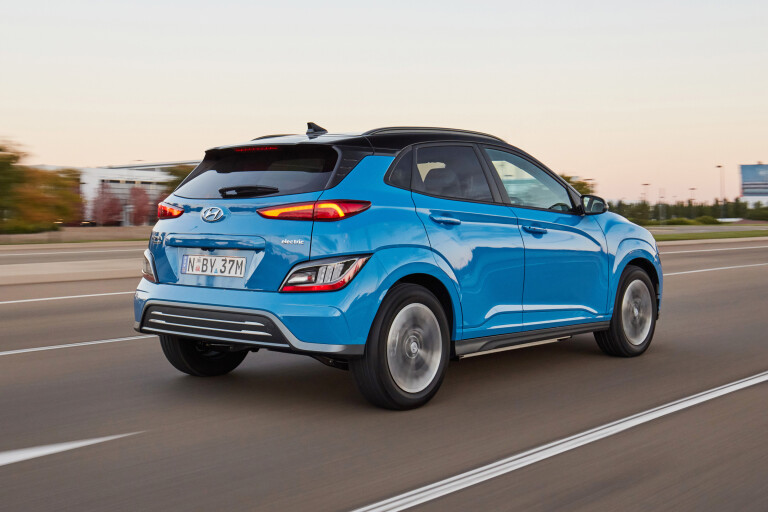
There’s value to be found when it comes to ongoing costs, too. Hyundai’s five-year/unlimited-kilometre warranty covers the Kona Electric, though Hyundai places an eight-year/160,000km warranty on its EV batteries. Hyundai also offers a free first service at 1500km or one month, though also gives buyers the $825 option of covering five years of scheduled servicing, up to 75,000km.
At $4000 more than the entry-level Elite, the top-spec Kona Electric Highlander comes standard with heated and cooled seats, a heated steering wheel, a retractable HUD panel, Hyundai’s newest infotainment system, which has a 10.25-inch display, and an eight-speaker Harman/Kardon audio system.
It also has a wide digital dash binnacle, that can be customised for layout, as well as wireless phone charging and a shift-by-wire button-controlled transmission instead of a traditional shifter, though whether this is a benefit is down to preference. Having to double-check which button is reverse can be unnecessarily stressful during a three-point turn.
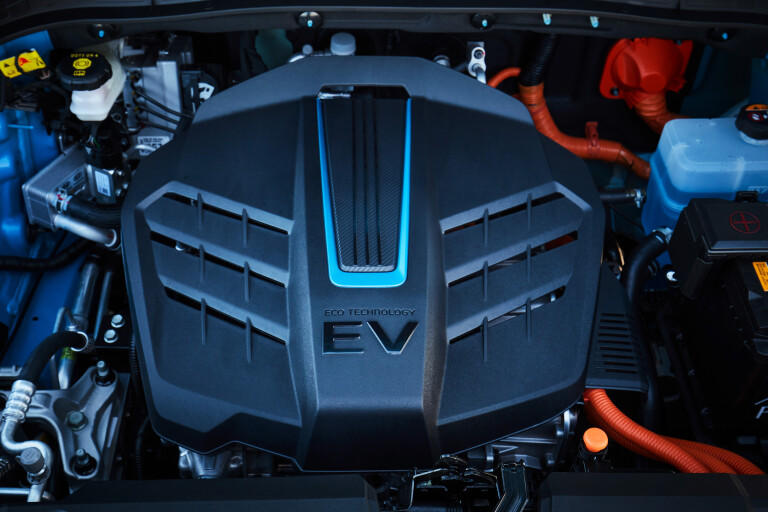
While it might be tempting to view it as an expensive alternative to its mainstream competitors, the Kona EV is actually going head-to-head with rivals like the Tesla Model 3
The seating position itself is comfortable, electrically adjustable (though there’s no memory setting) and allows the driver to reach everything easily, with simple HVAC controls under the infotainment touchscreen. Buttons down on the centre console are also laid out to avoid drinks in the cupholders getting in the way.
Especially compared to the pre-facelift Kona and even the current petrol Kona, the Highlander cockpit feels a pleasant, premium place from which to command 1743kg of South Korean EV.
Further back in the Kona, the second-row seating feels a little upright but is otherwise easy enough to settle into. There’s enough space for adults in terms of headroom and kneeroom but foot space under the front seats is tight, leaving a small area for feet to rest. It’s far from uncomfortable for an adult, however, and the light leather interior on our test car makes the second row feel perhaps more spacious than it is.
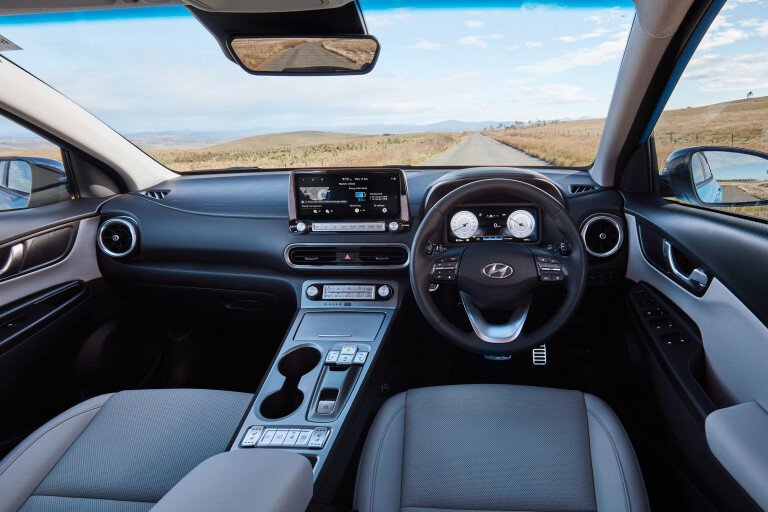
Speaker placement makes door storage tight but there’s a centre armrest with cupholders and a small storage space, and the outboard seats are even heated. There’s also a USB port, but no HVAC vents or control.
The Kona Electric’s boot isn’t exactly massive, inheriting only 332 litres of its petrol-powered sibling’s 361-litre boot. It’s below-average for its class, most small SUVs having between 350 and 500 litres but at a pinch, the space under the Kona’s boot floor can be used. It houses the cables and tyre puncture kit in a foam ‘bento box’ that holds the floor up.
Otherwise, the rear seats fold down and then you get 1114 litres. The boot opening is almost as wide and tall as the space inside, so loading and unloading is easy.
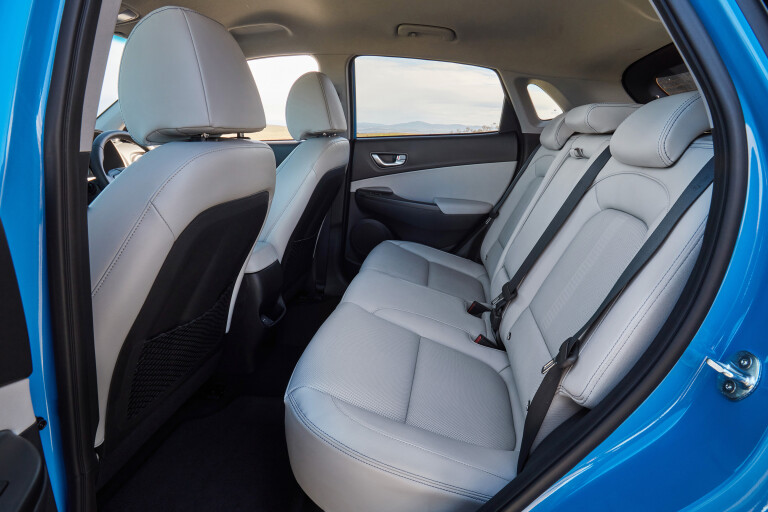
But you want to know what the Kona is like to drive, right? Well, in most aspects, the Kona Electric isn’t radically different from driving a petrol-powered car. Aside from two important distinctions. The first you’ll notice almost immediately, and that’s the way it accelerates. Most small SUV drivers won’t be used to the immediate surge of torque the Kona provides, all 395Nm being available pretty much immediately, with the ability to easily overpower the driven tyres (the fronts only) if you aren’t gentle enough on the go pedal.
Through bends and out of corners or roundabouts, the Kona’s drivetrain is powerful enough even in its Normal drive mode that Sport is essentially useless unless taking off in a straight line or onto a highway to impress your passengers. For most city driving, Eco is probably the better bet, giving the driver a much more gradual feed of torque.
The second main difference is regenerative braking. It can be quite intense if you’re not ready for the sudden slowing the first time you take your foot off the accelerator. But there’s a way to quickly make regen braking your best friend in the Kona EV.
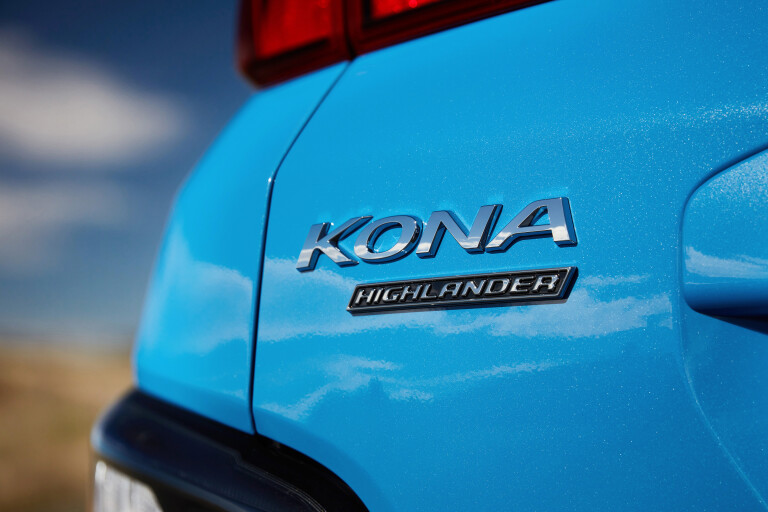
The excellent paddle adjustment system, behind the wheel where gear-shift paddles would normally be, means you can alter intensity on the go and even use the regen to avoid the brake pedal almost altogether. If you do need to use them, however, the front 305mm ventilated discs feel sturdy under hard braking.
Its three-stage regenerative braking system means you can minimise interruption to the Kona’s momentum or allow the car to retard its motion quite intensely – useful if you’re on a steep downhill and want to take the opportunity to charge the battery.
In fact, heavy use of the regenerative brakes during our testing resulted in an economy of 14.1 kWh/100km, which meant if we were to run the Kona from full to empty, we’d net about 454km of driving. This isn’t too short of the 484km claim made by Hyundai and more than enough to accommodate daily driving.

For the day-to-day, the Kona’s ride is overall comfortable, erring a little on the firm side. However, it’s able to soak up bumps (in part thanks to 17-inch wheels) enough to not unsettle its grip or upset passengers. Even a slightly rough road surface won’t send vibrations into the cabin to an annoying degree, even if they are sometimes noticeable.
In faster driving, the Kona handles well thanks to a low centre of gravity (courtesy of its battery layout) but it’s no focused corner-carver. Its eco-oriented Michelin Primacy 4 tyres grip well in regular, and even spirited country road driving, but won’t let you treat the Kona like a race car.
Keeping the Kona in check is made easier by its accurate steering. While not the most communicative, the steering provides feedback to the driver and isn’t unnecessarily weighty. Its rack speed is also easy to gel with.
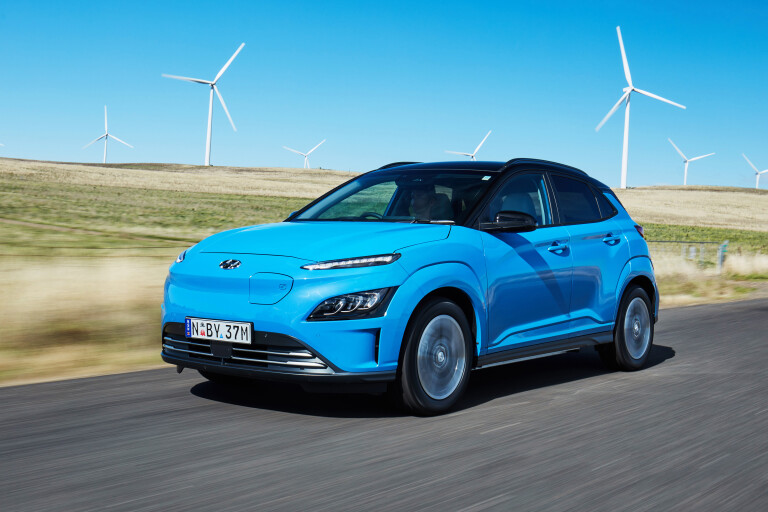
As something to ready a family for the shift to electric transport, the Kona Electric Highlander is a superb choice for early adopters who can afford it. Yet question marks around its value equation linger. Consider Mercedes is soon to launch the EQA at $76,800 and the Tesla Model 3 offers more range, interior space and load-lugging ability for $68,000 drive-away, and the Hyundai is facing off against some stern and arguably more desirable competition.
Yet its impressive list of standard equipment, strong real-world range and decent dynamics mean it remains a compelling addition to Australia’s burgeoning EV segment. We expect those who can justify the cost of the Highlander will have few complaints.

Hyundai Kona Electric Highlander specifications
| Body | Five-door, five-seat small SUV |
| Drive | Front |
| Motor | Permanent magnet/synchronous |
| Battery | 64.0 kWh |
| Total power | 150kW |
| Total torque | 395Nm |
| Weight | 1743kg |
| Power/weight | 86kW/tonne |
| Transmission | Single-speed reduction gear |
| Suspension | MacPherson struts (f); Multi-link (r) |
| L/W/H | 4205mm/1800mm/1555mm |
| Wheelbase | 2600mm |
| Tracks | 1564mm/1575mm |
| Steering | Electrically assisted rack and pinion |
| Brakes | 305mm ventilated discs (f); 300mm solid discs (r) with regenerative braking |
| Wheels | 17 x 7-inch Tyres |
| Price (before on-roads and options) | $66,000 |
Things we like
- High spec feels premium enough to rival Euros
- Range and charging both suitable for daily driving
- Power delivery and ride both pleasant, can handle some fun driving
Not so much
- Price out of reach for many
- Boot storage smaller than class average
- Small ergonomic quirks i.e. gearbox buttons

COMMENTS